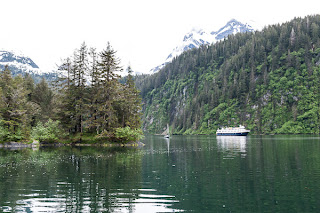Friday June 8 - Tuesday June 12
 |
| Bow Watch at Narrow Entrance to Devilfish Bay |
 |
| Early Morning in Devilfish Bay |
We have almost completed the second narrow passage which guide books caution about. Preparation for each transit was very intense. We studied the detailed charts. Looked at the tide table. We like to go through most narrows toward the end of a rising tide -- they say it's easier to get off a rock if the tide is rising and that makes sense! Then we calculated the time necessary to get to the entrance of the narrows. An hour before leaving, Urs studied the chart again. Going through, Judy was on the bow. Urs's eyes were glued to the chart, the plotter, the sounder, and the narrow surroundings. So far, all channels were well marked and at least 18 feet of water under Raven Song. One friend wished us at least 2 fingers of water under the boat, so I guess 18 feet was sufficient, though it's nerve wracking to see the sea floor.
 |
| Indian Paint Brush |
 |
| Dry Pass in El Capitan Passage -- Passage only at High Tide! |
We were disappointed in the scenery in El Capitan Passage; BC's Fjordland is much more impressive. However, halfway through, we had a wonderful anchorage at Devilfish Bay -- entrance was narrow and shallow, but we have a good bow watch and skipper. A native story tells that a devilfish rose out of the water there and washed away the entire village. The start to Saturday was foggy -- Urs got up at 5 AM and sat on the bow taking pictures until the sun came out. It was a glorious morning. 14 (56 F) degrees but t-shirt weather with the sunshine. When the clouds came in in the afternoon, we had to add a couple of layers; in such cases, I'm always reminded of a friend from Langara who said, "Boating is a fashion show!" We took a walk on the shore; saw beautiful Indian paintbrushes and other flowers.
 |
| Channel Markers at Dry Pass -- Red Right Returning or North |
Saturday afternoon, we raised the anchor and picked up our prawn traps. We caught 39 prawns. Found an unusual recipe in two books: heat al dente orozo with fried onion, tomatoes, pitted and sliced Kalamata olives, pepper, and prawns (I added celery); put half the mixture in a baking dish; cover with crumbled feta; cover with rest of mixture; bake. Delicious.
We transited Dry Pass successfully. People had assured us that it does go dry but we had enough water. The narrowest part of this passage was only about 50 feet, impossible for us to turn around. Anchored in Calder Bay -- lots of wind but excellent holding ground for the anchor.
 |
| Shallow Bay near Devil's Elbow |
 |
| Green Marker near Shallow Rock |
Then we headed toward Protection Cove, which was said to have a store and lots of artists. It was a lumpy 3-hour ride in Sumner Strait. One pamphlet said that Protection Cove has 65 inhabitants. So when we arrived and found the store closed, we were not surprised. However, the cove is small with no anchoring room and the docks were full. We went out to a large bay and searched charts and books for another spot to stay the night. The next spot was back out across Sumner to a bay that the fishermen like. Well, we would have to cross Sumner at some point and the wind was benign. We entered Alvin Bay on Kuiu Island slowly with a bow watch and the sonar turned on. There is no detailed chart and the information we had showed two rocks near the entrance. We entered without any problem and drew our own detailed chart. A band of sea otters peeked up over the kelp.
 |
| Channel Markers at Devil's Pass |
 |
| Bunch Berry |
Monday, we headed to our next challenge, Devil's Elbow (a 90-degree turn to the west) in Rocky Pass. Leaving Alvin Cove, we tried to take a short cut and found that the chart didn't match what we saw. So we turned around and went the longer route. We worried that the time wasted would cause us to enter the narrows too late. However, the current was with us; our speed over ground was up to 9 knots (18 km/hr or 15 mi/hr). If we didn't slow down, we'd get there too early (ie, too much current in the narrows). Again the passage was well marked and we had no problems. We're tucked into a quiet spot north of Devil's Elbow, just before the next narrows: "The Summit" -- high sea floor is not good.
 |
| Rainbow over Devil's Elbow |
Tuesday, we took the dinghy to see Devil's Elbow and got soaked in a sudden downpour. Came back to the boat. Sun came out. We visited the nearby Forest Service A-frame cabin. Beautiful location. It looks out on a very flat bay with fields of skunk cabbage, bunch berries, and something that I always call vanilla plant -- very fragrant. When we read the guest book, we understood why the bears are so very shy: almost all of the guests were hunters of bear, wolf, and deer. We hope that the pile of salt that we saw near the cabin was not to attract deer.
 |
| Common Murres Getting a Free Ride |
We have hardly seen any other boats since leaving Ketchikan. One boat followed us through El Capitan Narrows. Otherwise, just one sail boat and a couple of fishing boats.















































